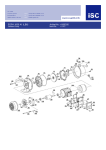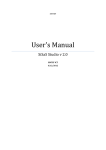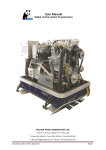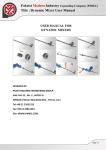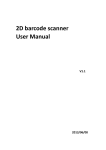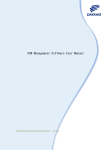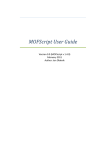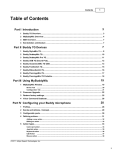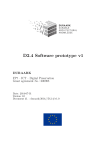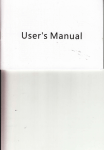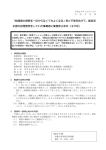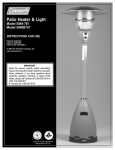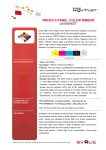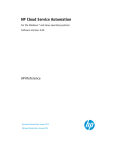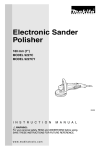Download Developer`s Manual
Transcript
SINTEF
Developer'sManual
SiSaSStudiov2.0
SINTEFICT
6/11/2012
DEVELOPER'SMANUAL
F OR S I S A S S TUDIOV 2.0
Version:1.0
Contributors:
FranckChauvel–SINTEF/ICT
Summary:
ThisdocumentbrieflyexplainshowtoaddnewfeaturesintheSiSaSstudiov1.0.Itfirst
outlinesthebasicsoftwaretoolsetneeded,anddepictsthemainarchitectureoftheSiSaSStudio.
Theadditionofasimplefeatureisgivenasatutorialandsomecommonissuesarediscussedto
conclude.
ChangeHistory:
Version
1.2
1.1
1.0
0.1
Date
June11,2012
June8,2012
Nov29,2011
Oct17,2011
ChangesDescription
Addsectionaboutbundlecreation
Introducethenewarchitecture
FirstVersion
InitialOutline
Author
F.Chauvel
F.Chauvel
F.Chauvel
F.Chauvel
©2009–2011SINTEF
1
1 CONTENTS
2 Introduction................................................................................................................................................................3 3 SettingupyourDevelopmentEnvironment.................................................................................................3 4 5 3.1 InstallingtheDevelopmentToolset........................................................................................................3 3.2 CheckingouttheSiSaSStudioSourceCode.........................................................................................4 ArchitectureoftheSiSaSStudio.........................................................................................................................4 4.1 ASetofEclipsePlugins.................................................................................................................................4 4.2 InternalArchitecture.....................................................................................................................................4 4.2.1 TemplateProjects.................................................................................................................................4 4.2.2 ModelTransformations......................................................................................................................5 4.2.3 ExistingModelTransformations....................................................................................................6 Tutorials.......................................................................................................................................................................7 5.1 5.1.1 DevelopingtheGeneratorscript.....................................................................................................7 5.1.2 DevelopingtheCheckerScript........................................................................................................8 5.1.3 RegisteringtheTransformation......................................................................................................8 5.2 6 DevelopingaNewTransformation.........................................................................................................7 AddinganewProjectTemplate................................................................................................................9 Troubleshooting....................................................................................................................................................10 6.1.1 7 UnabletoStarttheWorkbench....................................................................................................10 References................................................................................................................................................................10 ©2009–2011SINTEF
2
2 INTRODUCTION
SiSaSStudio[5]isanEclipsebundlethatenablestogeneratecode(Java[2]amongothers)from
variousmodels,especiallyfromUMLmodels[7].ThecorepartoftheSiSaSstudio[1]isbasically
asetofmodeltransformations,writteninMOFScript[4],andsomeadditionalJavaclassesthat
ensuretheproperintegrationofthesetransformationswithintheEclipseGUI[1].
TheSiSaSstudiobundlealsoincludesotherEclipsepluginsthatsupportcommondevelopment
tasksassociatedwiththemodel‐drivenmethodology:UMLmodellingusingthePapyrusUML
Editor[10],MathematicalmodellingusingtheOpenModelicaplugin[8,12],etc.Althoughthese
pluginsarebundledwithintheSiSaSStudio,theymustbeconsideredasthirdpartyelements,
andaremaintainedseparately.
ThisdocumentisaimedatpeoplewhoneedtoextendortofixbugsintheSiSaSStudio.It
isNOTaimedatpeoplewhomerelywanttouseit.PleaseconsulttheUserGuide[5]in
thiscase.
TheaimofthisdocumentistointroducethetoolsetusedtodevelopandextendtheSiSaSStudio.
Thefirstsectiondescribespreciselyhowtosetupyourdevelopmentenvironment.Thesecond
partthenbrieflydescribesthearchitectureofthemodeltransformationsthathavebeen
developedintheSiSaSStudio.
3 SETTINGUPYOURDEVELOPMENTENVIRONMENT
3.1 INSTALLINGTHEDEVELOPMENTTOOLSET
BelowarethemainstepstofollowinordertoconfigureyourSiSaSdevelopmentenvironment.
ThesestepsareonlyrelevanttosetuptheenvironmentneededtodeveloptheSiSaSStudioitself,
andisNOTrelevantifyouonlywanttouseit.
1. JavaDevelopmentKit(JDKv1.6).ThefirstelementtoinstallistheJavaDevelopment
Kit[2],whichincludestheJavavirtualmachine,andtheJavadevelopmenttools.Thisis
neededtoruntheEclipseIDE.ItisworthtonotethatyoucanrunEclipseovernewer
versionoftheJDK(e.g.,onJava7)butthecodeoftheSiSaSStudioitselfrequiresJava6.
2. Eclipse‐Modelling(v3.5.x,socalled"Galileo",NOThigher).Thesecondelementneeded
isadistributionoftheEclipseModellingFramework.Werecommendtheversion3.5as
someofthepluginsthatwillbelateraddedrequirethisspecificversion.
3. PapyrusUML[10]istheUMLeditoradvocatedbytheSiSaSstudio.Itcomesasan
EclipsepluginandcanbeinstalledinEclipseusingtheupdatesite.
4. MOFScript[4](v1.4orhigher)istheprogramminglanguageusedtowritethemodel
transformationsthatareprovidedbytheSiSaSStudio.TheMOFScriptlanguagecomesas
wellasanEclipsepluginprovidingsyntaxhighlightingandautomaticcompletion.The
MOFScriptplugincanbeinstalledusingtheupdatesite.
5. SVNPlugin.YoumightwantaswelltoinstallanadditionalSVNplugin,whichpermitsto
directlycommitthechangesyoumadetotheSiSaSsourcecodeintotheSiSaSrepository
(Sotheybecomeavailableforotherdevelopers).Basically,twomainpluginsare
©2009–2011SINTEF
3
available:SubclipseandSubversive.Bothofthemarecompatiblewiththerestofthe
toolset.
3.2 CHECKINGOUTTHESISASSTUDIOSOURCECODE
ThesourcecodeoftheSiSaSstudioisavailableonaSVNserver.Youcanretrieveitfromthe
followingURL:
https://cloud.catenda.no/svn/sisas/sisasstudio/
IfyouhavenotyetgotpropercredentialtoaccesstheSiSaSStudio,youmaycontacttheCatenda
staffinchargeoftheSVNrepository.
4 ARCHITECTUREOFTHESISASSTUDIO
4.1 ASETOFECLIPSEPLUGINS
TheSiSaSStudioismadeoffourmainEclipseplugins:
ProfilesplugindefinesasetofUMLprofilesthat
canbeusedwithintheSiSaSStudio,e.g.,SoaML,
migration,etc.
TransformationspluginbindstheEclipse
graphicalinterfacestothesetofMoFScript
transformations.Basically,itdrivesthe
MoFScriptengineandselectstheproper
transformationaccordingtotheUIevents.
ProjectTemplatesprovidestheuserwiththe
abilitytodefinehisownprojecttemplates,
assumingthatthetransformationheneeds
alreadyexistintheSiSaSStudio.
Featurespluginisbasicallyacollectionof
Figure4.1 Dependenciesbetweenthe
pluginsthatcomposetheSiSaSStudio
plugins.Itisusedasafaçade/containerbythe
EclipseFramework.Itdependsonthetwoother
plugins
SitepluginpermitstocreateanEclipseupdate‐sitefromwhichtheSiSaSStudioplugin
canberetrievedandinstall.ItisusedwhenbuildingtheSiSaSStudiobundle.
ThedependenciesbetweenthesefourpluginsaredepictedbyFigure1,aside.Forabetter
understandingoftheEclipsepluginframework,theinterestedreadermayconsult[5].
4.2 INTERNALARCHITECTURE
TheSiSaSStudioisbuiltasasortof"productline"ofmodelstransformations.Thebasicideais
toseparatetheideadefinitionofspecificmodeltransformationsfromtheircombinationto
generatecomplexcodestructures(e.g.,Mavenprojects).Tothisend,theSiSaSstudiolettheuser
define"projecttemplates"whereshespecifiestheorganizationofthecodesheneedsintermsof
adirectorystructurecontainingthe"to‐generate"artefacts.
4.2.1 TEMPLATEPROJECTS
©2009–2011SINTEF
4
edmodels(b
bundleinasseparateEcllipsemodelss)whichcap
pture
TemplatteProjectsaareseparate
theorgaanizationofthecodetogenerate,esspeciallycom
mplexstructuresincluddingmultiple
generateedartefacts.Althoughttheusercandefineisow
wnprojecttemplates,thheSiSaSStudio
comesw
withasetofpredefinedprojecttem
mplatessupp
porting(POJOprojects,O
OGC/WPSp
projects,
EJB,etc.)
Figure4.2
2TheProjecttTemplateme
etamodel
Asshow
wnbyFiguree4.2,"projeccttemplatess"basicallyd
describead
directorystrructureinwhichthe
neededartefactscanbeplacesoastoensu
uretheprop
pergenerateofthecomppleteproject.
dsetofgeneeratedartefaacttypes.Ad
ddinganew
wtypeofgen
nerated
Projectttemplatedeefinesafixed
artefactrequirestomodifythemodelofprrojecttempllateandhen
ncetoregeneerateandre
ecompile
dEclipseplu
ugin.
thecodeetherelated
4.2.2 MODELTRAANSFORMATTIONS
TheSiSaaSStudioisactuallyare
egistryofm odelstransfformation,e
eachofthem
mtargetinga
aspecific
typeofggeneratedarrtefact.Whileinstantiattingaspecifficprojectte
emplate,theesisasstudio
omerely
triggertthetransformationrelevantforeacchgenerated
dartefacts.
Eachtraansformationregistered
dintheSiSaaSStudiomaadeoftwoparts:generaatorsandch
heckers.
Generattorsareinch
hargeofeffe
ectivelygeneeratingthecode,where
easacheckeerisinchargeof
verifyingwhetherthemodelgivenasinputtbytheusercontainssufficientinfformationfo
orthe
generato
ortorunproperly.
Itisworrthtonotethattheconssistencybettweenagen
neratorand
ditsrelated
dcheckerissthe
responssibilityofth
hetransform
mationdeveeloper.
Figure4
4.3,belowilllustrateshowmodeltraansformatio
onregistered
dwiththeSiiSaSStudio.The
SiSaSStudioexplicitlydeclaresthetransfo rmationsth
hatareavaila
able,includiingthetwo
separateeMofScriptfilesandthe
etypeartefaacttheygen
nerate.Invok
kingthe"insstantiate"w
willthen
passthrroughthetemplatethat triggerthe generationofeacharte
efactusingthherelevant
transforrmation(orraiseanerrrorifnottraansformation
nareavailab
bletohandlleoneofthe
e
artefact)).
TEF
©2009–2011SINT
5
class Class Model
«singleton»
SisasStudio
+
instantiate(Model, Template) : void
1..*
«enumeration»
ArtifactType
+transformations 1..*
+definedTypes
+outputType
JSF_BEANS
SQL_DATA
1
JAVA_EJB
JSF_PAGES
XML_SERVICES_CONFIG
+config 1
Transformation
-
description: String
name: String
+
apply(Model) : void
+checker 1
1
Preferences
+implementation
MofScript
-
path: String
+
process(Model) : void
Figure4.3InternalrepresentationofmodeltransformationwithintheSiSaSStudio
RegisteringanewtransformationintheSiSaSStudioishenceamattersofafewlines,inthe
initializationoftheSisasStudiosingletonclass.Inthefollowingcodesnippet,weregisteredone
transformationthataimsatgeneratedPOJO(plainoldjavaprojects).
private SisasStudio() {
transfoRegistry = new Hashtable<ArtifactType, Transformation>();
// ---// ADD BELOW ANY TRANFORMATION THAT MUST BE AVAILABLE BY DEFAULT OR ANY
// NEW TRANSFORMATION THAT MUST BE SUPPORTED
//
List<Transformation> transformations = new LinkedList<Transformation>();
transformations.add(new Transformation("UML TO POJO",
ArtifactType.POJO_JAVA_CODE,
"uml_to_pojo/plain_java_checker.m2t",
"uml_to_pojo/plain_java_generator.m2t"));
transformations.add(new Transformation("UML to MAVEN POM FOR Java",
ArtifactType.POJO_MAVEN_POM_FILE,
"uml_to_pojo/maven_pom_checker.m2t",
"uml_to_pojo/maven_pom_generator.m2t"));
// ---// ...
}
4.2.3 EXISTINGMODELTRANSFORMATIONS
Scope
Storage
Persistence
Business
©2009–2011SINTEF
Input
UML
UML
UML
RequiredProfile
SoaML/Persistence
SoaML/Persistence
SoaML
Output
XSDSchema
SQLSchemaCreation
SQLSchemaDeletion
JavaClasses(POJO)
JEE6– EntityBeans
JEE6– EntityManagers
WS‐ WSDL
WS– Skeleton(JAX‐WS)
JEE6–StatelessSessionBeans
6
Presentaation
Develop
pment
Import//Export
JSPWebSeerviceClientt
UML
JSFSampleeSite
UML
Noone
MavenJEE
EProjectStru
ucture
Noone
Enterp
prise
ECoreModdel
Archittect
Table1.Overviewo
ofthemodelltransformaationsinclud
dedintheSiiSaSStudio
wn in the taable above, the
t SiSaS Sttudio contaiins a set of model trannsformationss that be
As show
applied on various models, mainly on UM
ML model, extended
e
with adhoc pprofiles. The source
nsiscontain
nedintothe"transformation"plugiin.
codeofaallthesetraansformation
Thetran
nsformation
nsincludediintheSiSaS Studiocanb
bedividedin
nthreecateegories.Thefirstone
containss all the traansformatio
ons that prooduce "prod
duction" code, i.e., codde that will be later
integratted in the final
f
applica
ation. In Taable 1, this first catego
ory correspponds to first set of
transforrmation (including sto
orage, persisstence, bussiness and presentatio n). The seccond set
containsstransformaationsthatg
generateco deusefulto
ocompilean
ndpackagetthefinalapp
plication:
basicallyy the transformation generating
g
the Maven Infrastructture. Finallyy, the last group
g
of
transforrmationcon
ntaintransfo
ormationsprrovidingcon
nversionme
eansbetweeendifferentttypesof
models(e.g.,converrtingEnterp
priseArchiteectModelin
ntoECoremo
odels).
5 TU
UTORIAL
LS
5.1 DEVELOPINGGANEWTRANSFORM
R
MATION
Agoodp
practicetoffollowwhile
eaddingnew
w
transforrmationsinttotheSiSaSStudio,istoofirstdevelo
op
andtesttthetransfo
ormationaside,andthen
ntointegratte
itwithin
ntheSiSaSSStudio.Thissectiondesccribesbrieflly
theseco
ondparts,naamelyhowtointegra
ateanew
transfo
ormation.IInterestedreadersmay
yreferto[4]
foradditionaldetaillsabouthow
wtowriteM
MoFScript
transforrmation.
Thisdon
neisthreem
mainsteps:
1. D
Developtheegeneratorr,aseparateeMoFScript
Figure
e5.1Structu
tureofthe
ttransformattionthatgen
neratesthen
neededcode
Transformationp
plugin
2. D
Developtheechecker,aMoFScript
ttransformattionthatche
eckswhetheeragivenUM
ML
m
modelispro
operregardingtherequ
uirementsofthegenera
ator
3. R
Registeran
newtransforrmationinth
heSiSaSStu
udiothatbin
ndtogethertthegenerato
or,the
ccheckerand
dthetypeoffartefactthaatisproduced.
5.1.1 DEVELOPIN
NGTHEGEN
NERATORSCR
CRIPT
Thecod
desnippetbeelowisaverrysimplem
modeltransfo
ormationtha
atmerelyprrintsawelco
oming
messageeontheEcliipseconsole
e.ItiswritteenintheMO
OFScriptlang
guage[4].T
Thenextpara
agraph
showsh
howtointeggratethistra
ansformation
nintotheSiiSaSStudio.
TEF
©2009–2011SINT
7
/**
* Test.m2t
*
Test whether the MoFScript Engine is ready for use.
*
* date: 29/10/2011
*
* author: Franck Chauvel - SINTEF
*/
texttransformation FooGenerator (in mdl:"http://www.eclipse.org/uml2/2.1.0/UML") {
mdl.Model::main () {
println("This is a test:" )
println("If you can read this message, MofScript is operational")
}
}
Thefilethatcontainsthiscodesnippetmustbeplacedintothetransformationdirectoryofthe
transformationplugin(oroneofitssubdirectories).Forthesakeofconsistentorganisation,we
recommendtoplaceitin"transformations/uml_to_foo/foo_generator.m2t"
5.1.2 DEVELOPINGTHECHECKERSCRIPT
Thefollowingcodesnippetsillustrateshowtowriteachecker,andespeciallyhowtoreturna
valuesthatcanbeunderstoodintheJavalayeroftheSiSaSStudio.Inthissimpleexample,the
checkeractuallychecksnothing,andrepliesthatthemodelsconformstherequirements,
sendingthe"CHECKER_PASS"message.
import "../configuration.m2t"
texttransformation FooChecker(in mdl:"http://www.eclipse.org/uml2/2.1.0/UML") {
mdl.Model::main () {
print(CHECKER_PASS);
}
}
This file must be saved in the transformation plugin in a separated directory (for sake of
organization).Forinstance,wemayplaceitinto"transformation/uml_to_foo/for_checker.m2t"
5.1.3 REGISTERINGTHETRANSFORMATION
ThesecondstepaimsatwritingapieceofJavacodethatregistersthegeneratorandthechecker
intheSiSaSStudio.Hence,instantiatingtemplatescontainingtherelatedgeneratedartefacttype
willhencetriggertheexecutionofboththegeneratorandthechecker.Thecodeexcerptbelow
illustrates such a registration: In the initialization of the SisasStudio singleton class
(org.sintef.no.sisas.transformation.SisasStudio), we add in the internal registry a new
transformationpointtothechecker,thegenerator,andtheartefacttype.
private SisasStudio() {
transfoRegistry = new Hashtable<ArtifactType, Transformation>();
// ---// ADD BELOW ANY TRANFORMATION THAT MUST BE AVAILABLE BY DEFAULT OR ANY
// NEW TRANSFORMATION THAT MUST BE SUPPORTED
//
List<Transformation> transformations = new LinkedList<Transformation>();
transformations.add(new Transformation("UML TO POJO",
ArtifactType.POJO_JAVA_CODE,
"uml_to_pojo/plain_java_checker.m2t",
"uml_to_pojo/plain_java_generator.m2t"));
transformations.add(new Transformation("UML to Foo",
©2009–2011SINTEF
8
ArtifactType.FOO_FILE,
"uml_to_foo/foo_checker.m2t",
"uml_to_foo/foo_generator.m2t"));
// ---// ...
}
5.2 ADDINGANEWPROJECTTEMPLATE
Additionally,newprojecttemplatescanbedefined,andhavetobedefinedtosupportnewtypes
of generated artefacts. The SiSaS studio includes a plugin which permit to build new project
templates. To do so, just create a new Project template file, as describe the structure of the
resultingsourcedirectory,asshownonFigure4.2below:
Figure5.2Definingnewprojecttemplatewiththeprojecttemplateeditor
Once the desired template has been designed and saved in a ".projecttemplate" file, it can be
eitherregisteredduringtheSiSaSStudiosession,usingtheSiSaSPopupmenu,orcopyintothe
SiSaS Studio installation, so as to pertain for later sessions. The transformation plugin has a
specific directory named "template" which is automatically browsed when the SiSaS Studio
starts, and each template placed there will be loaded and hence accessible in the SiSaS popup
menu.
5.3 CREATINGABUNDLEOFTHESISASSTUDIO
CreatingabundleofEclipsethatcontainsanupdatedversionoftheSiSaSStudioisasimple
process:
1. GototheupdatesiteoftheSiSaSStudioplugin(project
org.sintef.no.sisas.transformations.update).Thenrebuildtheupdatesite,buildright
clickingonPDEtool,andselecting"Buildsite".
2. Installabrandneweclipsedistributionandinstalltheneededpluginsinside,MoFScript,
Papyrus,etc.
©2009–2011SINTEF
9
3. StarttheneweclipseandselectFile‐>InstallNewSoftware.Selectalocalrepository,and
providethelocationoftheupdatesitedirectory(namelytheplacewhereyoucheckout
theorg.sintef.no.sisas.transformation.update).ThiswillinstalltheSisasStudiointhe
newEclipsedistribution.
4. ExitEclipseandcreateanarchivecontainingtheneweclipsedistribution(justzipthe
eclipsedirectory).Yourbundleisready,enjoy
6 TROUBLESHOOTING
ThissectionsummarizescommonproblemsthatmayoccurwhiledevelopingtheSiSaSStudio.
6.1.1 UNABLETOSTARTTHEWORKBENCH
WhenrunningtheSiSaSStudioasanEclipseWorkbench,youmayget"Couldnotreserveenough
spaceforobjectheap.CouldnotcreatetheJavavirtualmachine."Thismightbeduetoamismatch
betweentheJVMusedbyEclipsewhenitcreatesanewworkbench,andtheoneprovidedby
youroperatingsystem.Makesurethatthelatteroneisa32bitversion.Ifyouareusinga64bits
system,youmayneedtoinstallanolderversionoftheJVM,optimizedfor32bitssystems.
7 REFERENCES
1. EricClayberg,DanRubel.EclipsePlug‐ins.4thedition,Addison‐Wesley,2009.
2. BruceEckel,ThinkinginJava.4thedition,PrenticeHall,2006.
3. KitoD.Mann.JavaServerFacesinAction.ManningPublications,2005.
4. JonOldevik.MOFScriptUserGuide.Unpublished.Version1.0,February2011.(available
athttp://eclipse.org/gmt/mofscript/)
5. GøranK.Olsen.SiSaSStudio–UserManual.Volume1,2and3.Unpublished.
6. ObjectManagementGroup(OMG).ServiceorientedarchitectureModelingLanguage
(SoaML)‐SpecificationfortheUMLProfileandMetamodelforServices(UPMS)SoaML.
ptc/2009‐12‐09.2009.(seehttp://www.omg.org/spec/SoaML/)
7. ObjectManagementGroup(OMG).UnifiedModelingLanguage–Superstructure(v2.4.1).
formal/2011‐08‐06.2011.(seehttp://www.uml.org/)
8. OpenModelica.(Seehttp://www.openmodelica.org/)
9. DebuPanda,RezaRahmanandDerekLane.EJB3inAction.ManningPublications,2007.
10. PapyrusUML.(Seehttp://www.eclipse.org/modeling/mdt/papyrus/)
11. ChrisRichardson.POJOinAction:DevelopingEnterpriseApplicationswithLightweight
Frameworks.ManningPublications,2006
12. WladimirSchamai.ModelicaModelingLanguage(ModelicaML):AUMLProfilefor
Modelica.(availableathttp://www.openmodelica.org/index.php/developer/tools/134)
13. Sonatype.Maven:TheDefinitiveGuide.O'ReillyMedia.September2008.
14. EricVanderVlist.XMLSchemas:TheW3C'sObject‐OrientedDescriptionsforXML.O'Reilly
Media.June2002.
©2009–2011SINTEF
10














